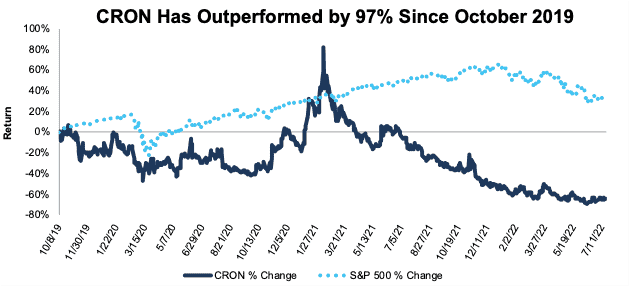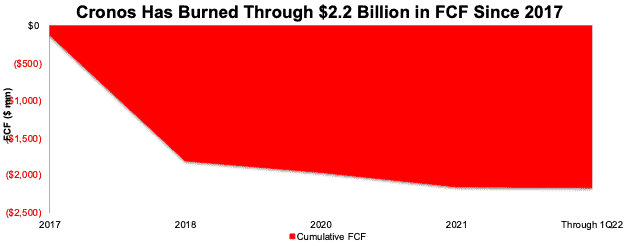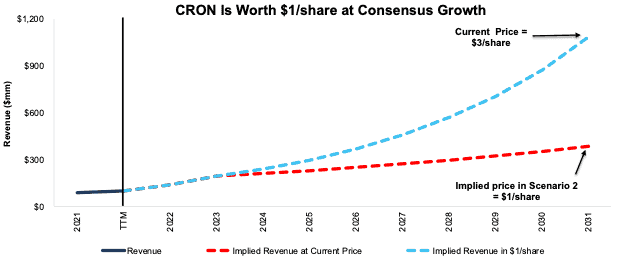We put Cronos Group Inc. (CRON: $3/share) in the Danger Zone in October 2019. Since our report, the stock has outperformed the S&P 500 as a short by 97%. Even after falling 86% from its 2019 high and 29% year-to-date, we think the stock has much more downside.
This report leverages our cutting-edge Robo-Analyst technology to deliver proven-superior fundamental research and support more cost-effective fulfillment of the fiduciary duty of care[1].
Cannabis stocks experienced a bubble and a burst in 2019, then staged a false rally in 2021 that has left prices falling for the past fifteen months. After a burnout like that, one might expect to find deals galore, and value investors are shopping the sector in earnest. Even after large declines, betting on these companies beating the expectations baked into their stocks’ prices isn’t for the sober minded. We warn investors against entering these value traps (look forward to more on this topic) until the industry experiences a wave of consolidation and the smoke has cleared.
CRON Is Still Risky Based on the Company’s:
- profitless growth
- cash-burning business
- stock could be worth as little as $1/share
Figure 1: Performance: From Date of Publication Through 7/18/2022
Sources: New Constructs, LLC
Why We’re Keeping Cronos in the Danger Zone
Given the issues we highlighted in our original report such as Cronos’ misleading GAAP earnings and non-GAAP metrics, unsustainable revenue growth rates, poor profitability, lack of scale, and expensive valuation of its stock, the stock’s underperformance comes as no surprise.
As anticipated, Cronos’ year-over-year (YoY) revenue growth rate has significantly slowed from 258% in 2018. The company’s trailing-twelve-month (TTM) revenue rose just 74% in 1Q22. Even more concerning for the company is its deteriorating profitability. Cronos’ Core Earnings fell from -$7 million in 2017 to -$168 million over the TTM.
The company’s return on invested capital (ROIC) has fallen from -8% in 2019 to -10% TTM. Cronos’ falling ROIC drove its economic earnings from -$173 million to -$298 over the same time.
Cronos’ operation is also a significant cash burner. Per Figure 2, since 2017, the company has burned -$2.2 billion (2x its current market cap) in free cash flow (FCF). As we’ve recently shown with zombie stocks like Carvana (CVNA), Freshpet (FRPT), and Peloton (PTON), companies that burn through cash are extremely risky in this market environment.
Figure 2: Cronos’ Cumulative Free Cash Flow: 2017 – 1Q22
Sources: New Constructs, LLC and company filings
Reverse DCF Math: Cronos’ Shares Have Further to Fall
Below we use our reverse discounted cash flow (DCF) model to analyze the future cash flow expectations baked into Cronos’ stock price. We also provide an additional scenario to highlight the downside potential in shares if Cronos’ revenue grows at more reasonable rates.
If we assume Cronos’:
- net operating profit after tax (NOPAT) margin immediately improves to 10% (more than double the 4% margin of farming companies under coverage[2], compared to Cronos’ -173% margin in fiscal 2021,
- revenue grows at 56% in 2022 and 38% in 2023 (equal to consensus), and
- revenue grows 24% compounded annually from 2024 – 2031, then
the stock would be worth $3/share today – equal to the current stock price.
In this scenario, Cronos would generate $1.1 billion in revenue in 2031, which is 11x its TTM revenue and 12x its 2021 revenue.
Keep in mind, the number of companies that grow revenue by 20%+ compounded annually for such a long period are “unbelievably rare”, making the expectations in Cronos’ share price outright unrealistic. In a more realistic scenario, detailed below, the stock has large downside risk.
CRON Has 67%+ Downside if Consensus Is Right
We perform a second DCF scenario to highlight the downside risk to owning Cronos should it grow at consensus revenue estimates. If we assume Cronos’:
- NOPAT margin improves to -5% in 2022, 0% in 2023, 5% in 2024, and 10% from 2025 – 2031,
- revenue grows at consensus rates in 2022 and 2023, and
- revenue grows 9% a year in 2025-2031, then
the stock would be worth just $1/share today – a 67% downside to the current price. This scenario still implies Cronos’ revenue grows to $386 million in 2031.
If Cronos fails to achieve the revenue growth or margin improvement we assume for this scenario, the downside risk in the stock would be even higher.
Figure 3 compares Cronos’ historical revenue to the revenue implied by each of the above DCF scenarios.
Figure 3: Cronos’ Historical and Implied Revenue: DCF Valuation Scenarios
Sources: New Constructs, LLC and company filings.
Each of the above scenarios also assumes Cronos grows revenue, NOPAT, and FCF without increasing working capital or fixed assets. This assumption is highly unlikely but allows us to create best-case scenarios that demonstrate the expectations embedded in the current valuation. For reference, Cronos’ invested capital has increased 118% compounded annually since 2017. If we assume Cronos’ invested capital increases at a similar historical rate, the stock’s downside risk is even larger.
This article originally published on July 20, 2022.
Disclosure: David Trainer, Kyle Guske II, Matt Shuler, and Brian Pellegrini receive no compensation to write about any specific stock, style, or theme.
Follow us on Twitter, Facebook, LinkedIn, and StockTwits for real-time alerts on all our research.
[1] Our research utilizes our Core Earnings, a more reliable measure of profits, as proven in Core Earnings: New Data & Evidence, written by professors at Harvard Business School (HBS) & MIT Sloan and published in The Journal of Financial Economics.
[2] Farming companies include Alico (ALCO), Cal-Maine Foods (CALM), Corteva (CTVA), Fresh Del Monte Produce (FDP), Limoneira Company (LMNR), Phibro Animal Health Corp (PAHC), SiteOne Landscape Supply (SITE), and The Andersons (ANDE).



